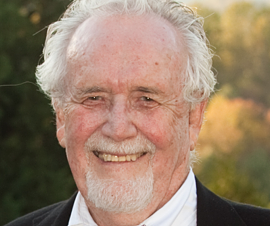Never Afraid of Living: William Chambliss, 1933-2014
Bill Chambliss, a transformative force in conflict theory, the sociology of law, and criminology, died on February 22. Told he had little time to live when first diagnosed with cancer seven years ago, Bill characteristically broke all the rules. He lived with cancer as he had lived his life: on his own terms. Bill continued his research, published, traveled extensively, and taught until the very end. As he told me seven years ago, “I’ve never been afraid of living, and I’m not afraid of dying.”
Bill Chambliss was indeed unafraid. Despite spending long hours in the library and the archives doing research, he much preferred to be where the action was. As he explained in his paradigm-changing book On the Take: “Going to the streets of the city, rather than the records, may bring the role of corruption and complicity between political, economic, and criminal interests into sharp relief.” During the course of a productive 50-year career, Bill repeatedly went to the streets. He hung out with such notorious organized crime chiefs as Meyer Lansky as well as low-level drug dealers and petty criminals in Seattle; poppy growers, heroin traffickers, and CIA chiefs in Thailand’s Golden Triangle; and pirates of many stripes, whenever he could find them.
Bill had a yearning for the street; he simply loved to be among those who were on the receiving end of an exploitive social system shaped by race and class. Even when not officially conducting research, he headed for the street. One personal example: After we arrived in Juneau after three sleepless rain-soaked nights camping on the deck of the Alaska State Ferry, Bill somehow managed to find an all-night poker game at a local Inuit hangout. (My wife and I headed straight to the nearest hotel; Bill claimed he won $100.) He had an unerring gift for seeking out those who lived in the ragged quarters, and a unique talent for framing their challenges in larger sociological terms. Bill’s research exemplifies the very best of C. Wright Mills’ sociological imagination. Bill lived the sociological imagination.
Bill had a yearning for the street; he simply loved to be among those who were on the receiving end of an exploitive social system shaped by race and class.
After earning his sociology B.A. in 1955 under the tutelage of Don Cressey at UCLA, Bill spent a year hitchhiking between labor camps as a migratory farm worker. There he learned first-hand about the everyday lives of the men, women, and children who lived in the most ragged of quarters. These were experiences that came to shape his work. After getting his sociology Ph.D. in 1962 at the University of Indiana, where he studied deviance under Alfred R. Lindesmith, Bill accepted an assistant professor position at the University of Washington in Seattle. He soon moved away from explaining crime and deviance in terms of such then-standard sociological framings as differential association (Cressey) or symbolic interactionism (Lindesmith). Bill instead began to develop his own approach, helping to shape the newly emerging theoretical framework termed conflict theory. This approach, radical in the early 1960s, traced its origins to Marx’s emphasis on the universality of social conflict in class-based societies. Conflict theory argued that societies are best understood in terms of structurally embedded conflicts between social groups, as opposed to the then-prevailing functionalist view of societies as systems whose components inevitably function to produce overall social system stability.
Bill’s first major published article, “A Sociological Analysis of the Laws of Vagrancy,” appeared in 1964 in Social Problems, and catapulted him to the forefront of the nascent conflict theory approach. In this seminal and widely cited article, he began with Marx’s writings on the 14th through 16th century English vagrancy laws, which had classified peasants made landless under the enclosure movement as vagrants. Bill generalized from Marx’s analysis, arguing that vagrancy laws had been enacted by different ruling elites throughout history, in order to provide those elites with low-cost quasi-slave labor. Eventually, he argued, vagrants came to be defined as criminals – an important shift for understanding the criminalization of the poor in class-based societies, including the United States.
In 1967 Bill moved to UC Santa Barbara as a tenured associate professor. This proved to be a highly productive period, including seven books that significantly impacted criminology and the sociology of law. Despite this intense pace of publishing, Bill remained close to UCSB’s version of the street, serving as faculty adviser to the Black Students’ Union during a time when tensions between the BSU and local police were at a flash point. The BSU had demanded the creation of a black studies program, and occupied the computer center in hopes of achieving that goal. (They eventually did.) The police, falsely believing the occupiers to be armed, were poised to move in. Bill played the key role in diffusing a tense situation, thereby avoiding a potentially bloody police crackdown on the occupiers.
In1969 Bill published Crime and the Legal Process, the first major monograph to set forth his evolving ideas. This important work sought to show how lower-class black crime was rendered more visible than middle-class white crime, resulting in much higher rates of criminalization among blacks. A similar argument was made in his ethnography of small town street gangs, “The Saints and the Roughnecks” (1973). This widely cited classic (even today it results in nearly 90,000 Google hits) was reproduced in virtually every sociology textbook for a generation. In it Bill shows how the petty crimes committed by white middle-class gang members resulted in a slap on the wrist, while the same crimes, when committed by white lower-class gang members, led to criminal records with lifelong adverse consequences. Bill also published the first research to come out of his Seattle experience, Boxman: A Professional Thief’s Journal (1972). Bill gave voice to the life story of safecracker Harry King, by letting King tell his story in his own words.
During this period Bill and law professor Robert Seidman collaborated on a seminal textbook, Law, Order, and Power (1971), showing how class interests not only become law, but also shape the entire criminal justice system. Bill also published three edited books reflecting his developing understanding of law and social conflict: Sociological Readings in the Conflict Perspective (1973), Problems of Industrial Society (1974), and Criminal Law in Action (1975). In collaboration with sociologist Thomas Ryther, he also published his first introductory sociology textbook, Sociology: The Discipline and its Direction (1975). Two more were to come: one which he and I co-authored in 1997 – the first to mainstream globalization into a U.S. introductory textbook – and one with sociologist Daina Eglitis in 2012.
The University of Delaware hired Bill in 1976, where he published the book that was to establish him in the forefront of his field. On the Take: From Petty Criminals to Presidents (1978), which was based on his earlier Seattle research, exposed white-collar crime and corruption in that supposedly squeaky-clean city. In a rich, detailed, and inevitably controversial account, Bill argued that organized crime was not the result of the Mafia (or Cosa Nostra, as it had been relabeled during congressional hearings in the late ’60s), but was rather “a political phenomenon which takes its character from the economic institutions that exist at a particular point in time.” Organized crime is central to politics, from the precinct to the presidency. Bill developed these ideas more fully under the concept of “state organized crime” in an important series of writings: Organizing Crime (with criminologist Alan Block, 1981); Whose Law? What Order? (with sociologist Milton Mankoff, 1981); Exploring Criminology (1988), where even piracy was found to be a form of state organized crime (Sir Francis Drake was knighted by Queen Elizabeth for plundering Spanish ships and towns), and Making Law: The State, The Law, and Structural Contradictions (co-edited with sociologist Marjorie Zatz in 1993).
Nor did Bill mince words when he described state organized crime in his 1998 presidential address to the American Society of Criminology, whose annual meeting he themed “Crimes By and Against the State:”
The most important type of criminality organized by the state consists of acts defined by law as criminal and committed by state officials in the pursuit of their jobs as representatives of the state. Examples include a state’s complicity in piracy, smuggling, assassinations, criminal conspiracies, acting as an accessory before or after the fact, and violating laws that limit their activities. In the latter category would be included the use of illegal methods of spying on citizens, diverting funds in ways prohibited by law (e.g., illegal campaign contributions, selling arms to countries prohibited by law, and supporting terrorist activities).
In 1986 Bill relocated to the Sociology Department at George Washington University, where he remained until his death. There he turned his attention to more local victims of state organized crime: residents of the District of Columbia’s poorest black neighborhoods. To show the relationship between race, class, and criminalization, Bill amassed extensive statistical data about neighborhood characteristics, crime, and incarceration. But he also participated in “ride-alongs” with the self-styled “Dirty Harrys” of the Washington Police Department’s Rapid Deployment Unit, in order to better understand how policing played out on the street. This research found its way into his 1993 presidential address to the Society for the Study of Social Problems, and eventually his book Power, Politics, & Crime (1999), where Bill argued that the “war against drugs” was both misplaced and a failure. He also showed that the media, police, and what has come to be known as the prison-industrial complex had manufactured the crime panic over supposedly predatory black males. In many ways this recent work reprises Bill’s earliest insights from his original studies of vagrancy: criminalization, he shows, is part of a draconian system resulting in “the ghettoization of the African American community and the creation of an intractable class of abjectly poor.”
Bill continued making this argument until a few weeks before his death. In a Huffington Post article entitled “Obama’s Drug Problem” that appeared on January 26, Bill again proved that he was a fighter for justice until the end. Never one to pull his punches, he pointed out both the hypocrisy and systemic corruption of the war on drugs:
Barack Obama admits to having tried cocaine and marijuana but has overseen the largest increase in imprisonment for drug possession in the country’s history…. Law-enforcement agencies are themselves “addicted” to drugs. They have grown dependent on the crime-fighting statistics generated by drug arrests. The employment of prison staff depends on extraordinary rates of incarceration. The money that law-enforcement agencies generate from confiscating property seized in drug busts funds equipment, enhances salaries and pays for weapons.
Bill Chambliss was a towering figure in sociology. The author or co-author of nearly two-dozen monographs and edited books, along with countless chapters, journal articles, and popular pieces, he received numerous prestigious awards throughout his career. Among these are the Presidencies of the American Criminological Society and the Society for the Study of Social Problems, previously mentioned; Lifetime Achievement Awards from the American Sociological Association’s sections on Criminology (1985) and the Sociology of Law (2009), as well as the Society for the Study of Social Problem’s section on Law and Society (2009); the American Criminological Society’s Major Achievement Award (1995) and Edwin H. Sutherland Award (2001); and the Academy of Criminal Justice Sciences Bruce Smith Sr. Distinguished Leadership in Criminal Justice Award (1986). In 2008 Bill gave the Beto Chair Lecture in Criminal Justice at Sam Houston State University, and the following year he received an honorary Doctorate of Law from the University of Guelph, Canada.
Reflecting his role as a teacher-scholar, mentor for many of today’s leading criminologists and sociologists of law as well as thousands of students throughout his career, Bill received a singular honor from the Society for the Study of Social Problems in 2012: the creation of the William J. Chambliss Lifetime Achievement Award “to recognize career-spanning excellence and achievement in the area of law and society.”
Bill will be greatly missed by his wife Pernille, his sons Jeff and James, and daughter Lauren, his grandchildren, his students, his many friends. His legacy will live on in their memories, his writings, and the imprint he has left as a scholar who was never afraid to speak truth to power.





























































































Please note that Bill’s paper on vagrancy laws was *not* influenced by Marx, because Bill had not read Marx yet at that time. It is a strange case of independent discovery of sorts. Once published, however, the paper did lead Bill to read Marx because others had begun to identify him as a Marxist. Bill discuses this strange influence after-the-facts in an speech he gave at the ASA sociology of law section. It is online via youtube.
I agree with you here mate
Yes, speak TRUTH to power!! One great man!!